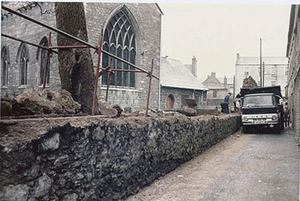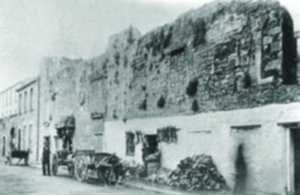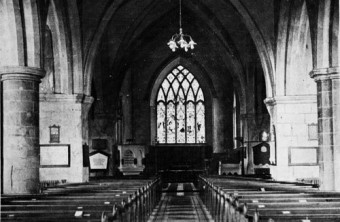Search Results for 'College House'
5 results found.
Lowering the old wall

Church Lane was a dark place up until 1983 because of the very large high stone wall that ran the length of it. This was part of a wall that was built around St Nicholas’ Collegiate Church and its adjoining graveyard. The removal of most of the wall and its replacement by the railings that once surrounded Eyre Square was one of the earliest ideas for improving Galway as it prepared for the Quincentennial in 1984. This project transformed the area around the church, making it much more attractive and opening it up to the passing public. It let a lot of light into the city centre.
De Burgo’s mansion

This wonderful photograph, dated c1865, shows a carved stone doorway in Market Street, an interesting example of Renaissance work, almost certainly earlier than the Browne Doorway.
Market Street, one hundred years ago

The title of this photograph is ‘Old Building, Market Street’ and it was taken about 100 years ago. The building in the foreground was at one time occupied by the Augustinian nuns who were based in Galway (where the Mechanics is today in Middle Street) before 1651. The last Augustinian nun to die in Ireland is buried in Forthill. These sisters formed part of the same Augustinian Order as the friars, as do their contemplative successors today in countries like Spain and Italy. Continuing persecutions and other historical pressures saw to the end of these nuns in Ireland, though some lingered on in Galway up to the middle of the 19th century.
College House, a brief history

This photograph was originally taken in 1983 as the corporation was preparing to knock down the high wall that ran around St Nicholas’ Collegiate Church and replace it with the railings that had surrounded Eyre Square… one of the better Quincentennial projects that helped improve the face of Galway.
The strange case of Warden Bodkin’s hand...

In March 1838, workmen, under the supervision of a Mr Clare, were carrying out repairs on the vaults and tombs near the main altar of St Nicholas’ Collegiate Church. They made a remarkable discovery. A body, which had rested in a tomb for 129 years, had been discovered incorrupt. Incredibly it was the remains of the last Roman Catholic warden John Bodkin, who when handing over the keys of the church to Williamite soldiers, after the town’s surrender on July 26 1691, cried out in despair: “ My God, that my right hand may not decay until the key of this church be restored to its proper owners”.

